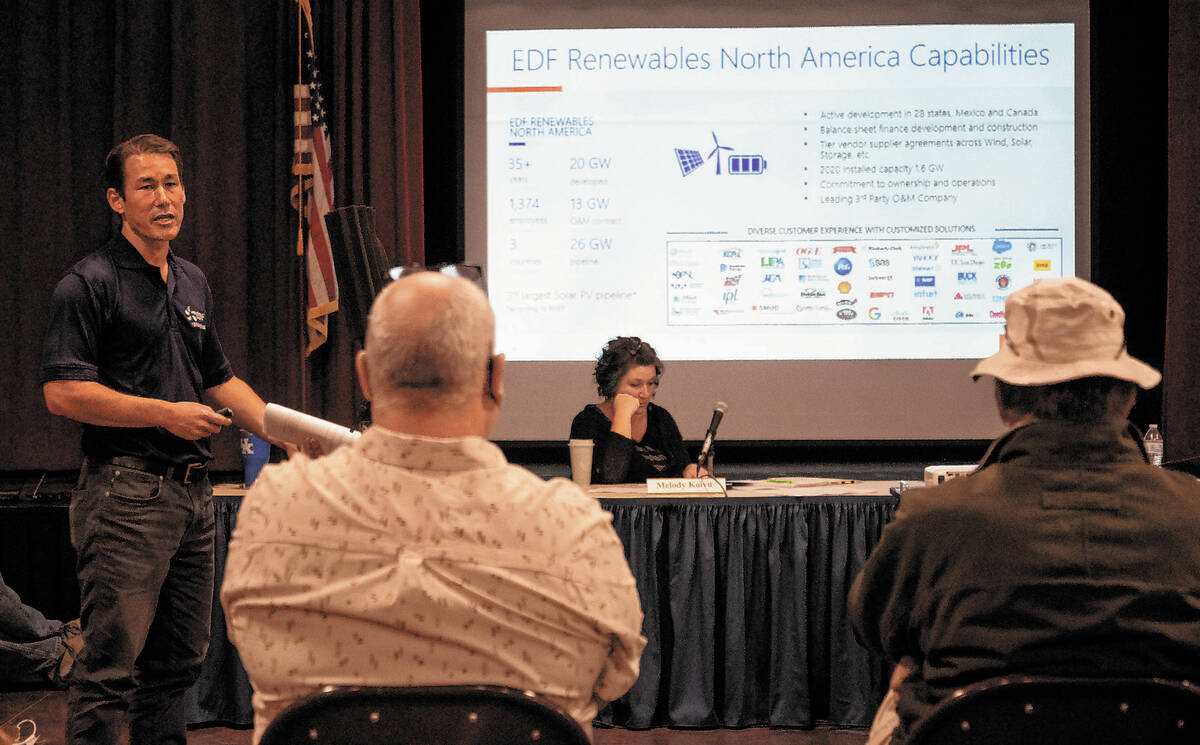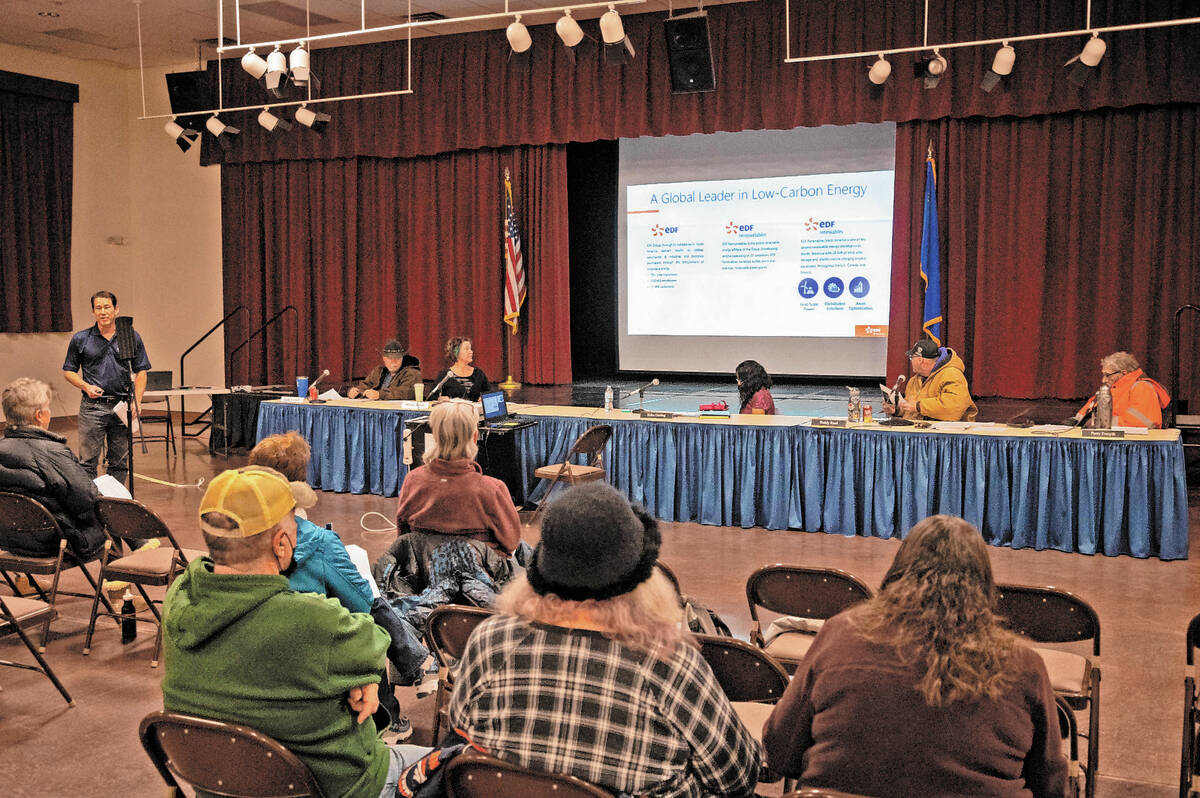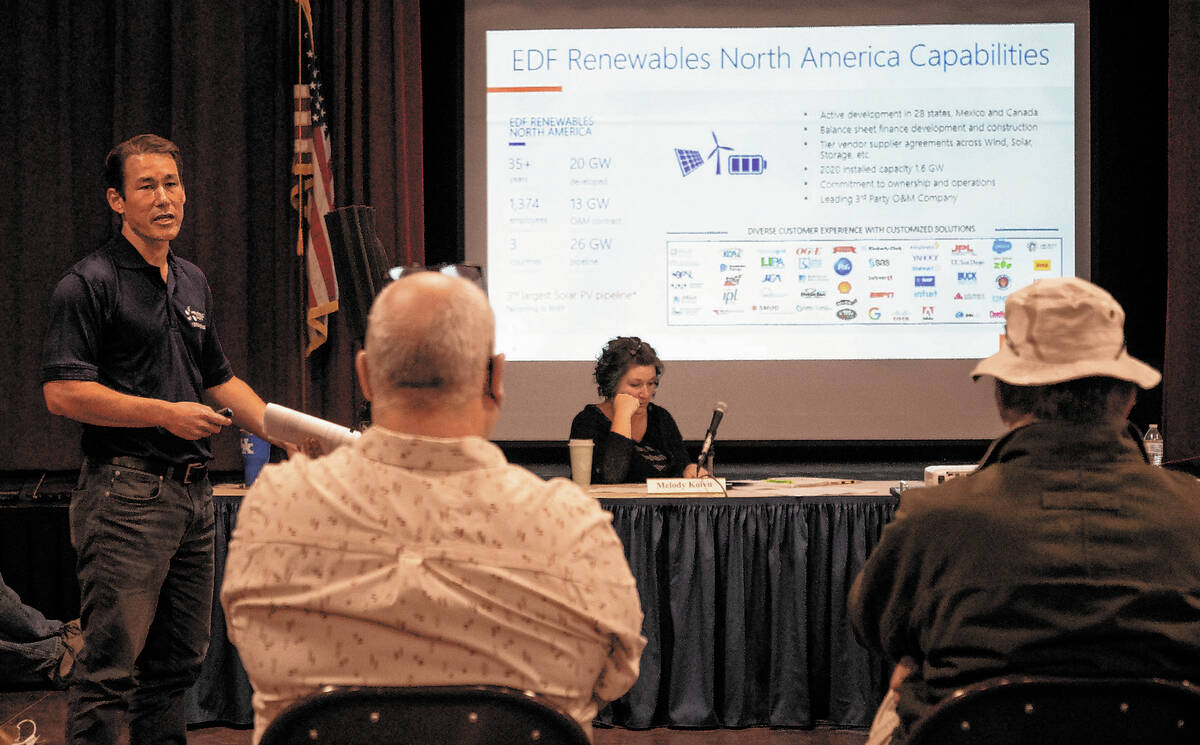Beatty resists proposed solar project
When Devon Muto, from EDF Renewables gave a presentation at the Beatty Town Advisory Board’s Jan. 31 meeting about his company’s plans for a utility-scale solar project near Beatty, he had about as much success in winning over the board members and most of the audience as Nancy Pelosi at a Trump rally.
The EDF North American subsidiary is part of a larger French-based renewables company active in 22 countries around the world. It is one of many companies eyeing the development of solar projects to take advantage of the planned Green Link West power transmission project.
Muto did what he could to soften locals’ view of his company’s project.
He said that they had reduced the acreage of the project, and that not all the land would be actively utilized.
He also emphasized that it was in the very early stage of development. He said that the preliminary part of the process usually takes six to 18 months.
If successful, the Bureau of Land Management’s NEPA process takes two to three years, and then, if permitted, the preconstruction and construction takes another two to three years.
Questioned by Karl Olson on whether EDF had thoroughly studied the local conditions and economy before applying to the BLM for a permit, Muto listed some of the “due diligence” that the company had done beforehand, but said that, with the flurry of applications being submitted by many companies they had to rush to get theirs in.
The objections voiced by the board and audience members mostly had to do with three concerns: impact on the town’s tourist and off-road destination economy, visual impact on the landscape, and harm to the desert ecology.
Board chair Erika Gerling stressed that the town has been working for ten years to position itself as a destination for off-road recreation. The fear is that large-scale solar projects could disrupt the trail system that had been developed and make the desert less attractive for visitors seeking a remote experience with nature.
Muto said that the EDF would do what it could to mediate the visual impact and could even help by improving trails. and developing trailheads, informational signage and restroom facilities.
Olson expressed strong concern about the extreme dust conditions that result when the desert crust is broken, and when Muto talked about using water to keep the dust down and recreate the crust, this tied in with the question of how much water the project would use and where it would come from.
Muto said that it would use a lot of water only during the construction phase, and that they would preferably acquire water from a local provider, but have done projects in which they have trucked water to a site.
The BLM has also changed its regulations on the construction of such projects and no longer allows the land to be bladed.
As for the visual impact, Muto said that EDF recently developed a project near Joshua Tree, Calif., so it can be done near a park.
“I think you can do it so it’s not a significant visual impact,” said Muto, something those in attendance obviously did not find convincing because of the scale of the project.
One suggestion was that these projects should be located on the east side of Highway 95 rather than on the west or they could be built on the Nevada Test and Training Range.
Muto said he did not know about the feasibility of putting them on the NTTR, but that the topography on the east side of the highway was more challenging. Large-scale solar projects generally require flat ground, no more than a five-percent slope, and preferably less.
He also said that it was not feasible to produce the amount of energy needed by utilizing roof-top solar panels. For one thing, the cost of roof-top solar is significantly higher that utility-scale production.
Board member Kelly Carroll wondered why the company hadn’t instead applied to use the Valley Electric Solar Energy Zone in Amargosa Valley.
Muto said that no applications were being accepted for the Solar Energy Zone because the BLM is planning to put it up for auction.
“What’s in it for Beatty?” was the focus of several questions from the audience. Would it bring jobs? Would they hire locally? Would Beatty be getting any of the power generated?
Muto said that EDF wanted to be a “good neighbor,” and could help out with things the town might need. He said they might provide educational opportunities as well.
As for jobs, he said they try to hire locally as much as possible. And regarding where the power would go, the grid is complicated, and while most, if not all, of the power is intended for Nevada, utilities share power in many directions.
Following the presentation, the board took up the agenda item of deciding whether to send a letter to the BLM asking the agency to decline to move EDF’s permit application forward or to assign the project a low priority status.
Saying that he hated the word “progress,” board member Perry Forsyth gave his assessment: “It’s going to interfere with a lot of things. This is our home. What you see out here is our back yard. We want to protect it. You’re an outsider.”
As the matter of the letter came up for a vote, resident Gus Sullivan objected to the board sending a letter speaking for the people of Beatty when there were those, including himself, who had not participated in the process of creating it. He said that the letter was “premature,” and suggested that the board conduct a survey of the townspeople on the subject.
Gerling responded that the board had held meetings and a workshop, had heard from many people, and that the response to the solar projects has been heavily negative.
The board then voted 4-1 in favor of sending the letter, with Carroll objecting, saying that he had “a lot of respect” for Sullivan and for his wife Teresa, who had also voiced objection.
The board also voted, this time unanimously, to direct the staff and the Beatty Solar Project Committee to schedule a non-public workshop to gather information about BLM land use designations and other planning related topics.
Richard Stephens is a freelance reporter living in Beatty.



















